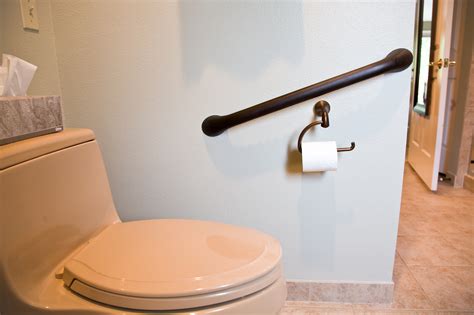How to Position Your Grab Bars | Grab Bar Placement
How to Position Your Grab Bars | Grab Bar Placement
When placing grab bars, it’s usually not a one-size-fits-all—it should be personalized based on the person’s body size, abilities, and the layout of their home. Think about where support is needed: usually near toilets, showers, and entryways. The key is to support natural movements in places your hands usually go when standing, or stepping over thresholds. These are our most recommended grab bar positions based on our years of experience.
We prioritize limiting the number of grab bars installed so they are as effective as possible in the majority of situations. It can be challenging to place grab bars in a functional place and hit studs. So we've found these positions work the best for most people.
Why we know this works
Why we know this works
These are our most frequently recommended grab bar positions. This a good place to start and should be modified based on your home and needs. In our experience these set ups have worked for most people and situations.
How to access this resource
How to access this resource
Frequently Asked Questions
Frequently Asked Questions
Q: How does the How to Position Your Grab Bars guide work? This comprehensive guide provides personalized recommendations for grab bar placement based on individual body size, abilities, and home layout. It focuses on supporting natural movements and identifying the most effective positions where your hands naturally go when standing or stepping over thresholds.
Q: What areas of the home does this grab bar positioning guide cover? The guide covers the most critical areas where grab bars are needed: near toilets, in showers, and at entryways. These locations are prioritized based on years of experience helping people improve bathroom and home accessibility safely.
Q: How do I know if the grab bar positions will work for my specific needs? The guide emphasizes personalization based on your unique body size, physical abilities, and home layout. Rather than a one-size-fits-all approach, it helps you identify where support is most needed for your individual situation and natural movement patterns.
Q: Will this guide help me install grab bars in the right structural locations? Yes! The guide addresses one of the biggest challenges - placing grab bars in functional positions while ensuring they hit wall studs for proper support. The recommended positions are specifically chosen because they work best for most people while meeting structural requirements.
Q: How many grab bars do I actually need according to this guide? The guide prioritizes limiting the number of grab bars to only what's necessary for maximum effectiveness. Rather than over-installing, it focuses on strategic placement of fewer bars that provide the most support in the majority of situations.
Q: Is this grab bar positioning guide suitable for different mobility levels? Absolutely. The guide takes into account varying abilities and provides recommendations that can be adapted for different mobility needs, from those who need minimal support to individuals requiring more comprehensive assistance.
Q: What makes this grab bar positioning approach different from standard installation guides? This guide is based on years of real-world experience in accessibility solutions, focusing on practical effectiveness rather than generic recommendations. It emphasizes supporting natural movements and strategic placement for maximum benefit with minimal installation.
Q: Can I use this guide if I'm helping someone else with grab bar installation? Yes, the guide is designed to help anyone - whether you're installing grab bars for yourself or assisting a family member or client. It provides clear guidance on assessing individual needs and determining the most beneficial placement locations.
Share




Solve the whole puzzle! Get more education, resources & services
-

Caregiver Training Courses
Go to website for the full training library We've partnered with Higher...
Dive Deeper: A knowledge base of solutions for real caregiving questions
View all-

👵 Gift Giving Guide for Grandparents - Top 5 Mo...
Discover the top 5 mobility aid gifts that help grandparents stay confident, safe, and independent. From rollator-wheelchair combos to walking sticks and reacher tools, these OT-approved picks make everyday movement...
👵 Gift Giving Guide for Grandparents - Top 5 Mo...
Discover the top 5 mobility aid gifts that help grandparents stay confident, safe, and independent. From rollator-wheelchair combos to walking sticks and reacher tools, these OT-approved picks make everyday movement...
-

💪 Gift Giving Guide for Hip & Knee Replacement ...
Discover OT-approved gifts that support healing and confidence after hip or knee replacement surgery. From bedside rails and bed trays to rollators, sock aids, and reachers, these tools make recovery...
💪 Gift Giving Guide for Hip & Knee Replacement ...
Discover OT-approved gifts that support healing and confidence after hip or knee replacement surgery. From bedside rails and bed trays to rollators, sock aids, and reachers, these tools make recovery...
-

👵 Gift Giving Guide for Grandparents - Top 5 Dr...
Discover the top 5 mobility aid gifts that help grandparents stay confident, safe, and independent. From rollator-wheelchair combos to walking sticks and reacher tools, these OT-approved picks make everyday movement...
👵 Gift Giving Guide for Grandparents - Top 5 Dr...
Discover the top 5 mobility aid gifts that help grandparents stay confident, safe, and independent. From rollator-wheelchair combos to walking sticks and reacher tools, these OT-approved picks make everyday movement...










